The card
The card
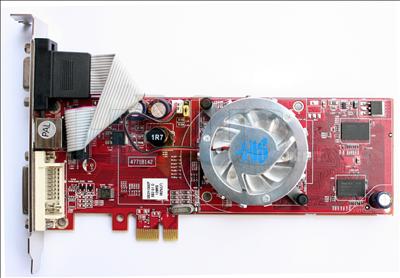
What's peculiar about this effort, then? Most readers, we bet, will say that the half-height nature of the PCB, making it perfect for a multitude of HTPC-orientated cases, is what's different from the norm. That's true enough, but take a closer look at how the card interfaces with your motherboard.
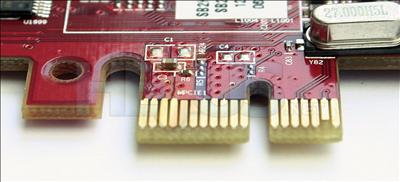
This HIS card hooks up to your system by using a physical x1 PCI-Express interface, rather than the x16 we're used to seeing. Thinking about it for a second, even a x1 PCIe lane provides 250MiB/s of bandwidth in either direction (500MiB/s in total), and the Radeon X1300's architecture isn't one to overly tax motherboard's PCIe-to-chipset bandwidth limits.
Having a x1 interface also makes it useful in instances where low-cost motherboards don't feature a discrete x16 PCIe slot but do specify a couple of x1 slots for peripheral connectivity (Dell, anyone?). We've often stated that it's about time that a greater number of cards/peripherals were released to take advantage of the benefits of x1 PCIe, and HIS has been one of the first to do so. We'll investigate how this lack of bandwidth is manifested in our performance benchmarks. It's also worth noting that the card is CrossFire compatible, via software, so supposed bandwidth restrictions will become all the more interesting.
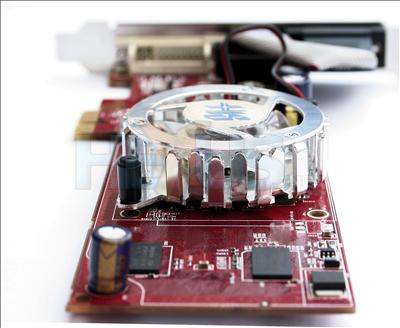
A look at the front reiterates the svelte form-factor. A lack of PCB space, we suppose, is the reason why HIS hasn't adopted a passive-cooling design. The fan spins fairly quietly during 3D load and will only be noticeable in the quietest of systems. The GPU operates at 450MHz and the ultra-threaded architecture makes use of Shader Model 3.0 effects for high image quality gaming, although a lack of pure grunt will compromise performance with modern games and eye candy turned on.
The HIS X1300 x1 is physically equipped with 128MiBs of onboard GDDR2 memory from Hynix which runs at 500MHz. The card also leverages ATI's HyperMemory technology, which can borrow up to 512MiB of system memory, assuming there's at least 1GByte system RAM, as a means of creating a larger framebuffer. However, coming back to the x1 PCIe interface and thinking of HyperMemory in relation to this, system bandwidth, if required, will need to be transferred by that x1 PCIe (250MiB/s) interface, thereby significantly reducing available bandwidth when HM is used.
Onboard memory, though, is connected via a 64-bit interface, offering a potential 4GiB/s of bandwidth. Remember, though, a lack of memory bandwidth once HyperMemory is used will have a negative impact on performance when compared to a card equipped with a dedicated 512MiB framebuffer and running off a x16 PCIe slot.
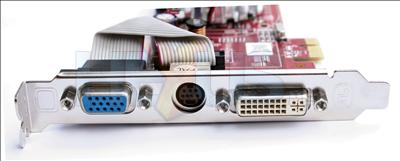
The HIS X1300 512MB DDR2 PCIe x1 offers the usual array of connectivity. There's HD15 on the left, TV-Out in the middle (no VIVO on this card, folks), and DVI to the right. It's worth noting that the card supports dual-link DVI, such that it can drive displays with esoteric resolutions. Dell's 3007WFP 2560x1600-resolution panel always springs to mind. Keeping in with ATI's aim of delivering image quality excellence, this X1300 carries the company's Avivo video-processing technology, too.
Note the ribbon cable attached to the HD15 port? Here's the reason why:
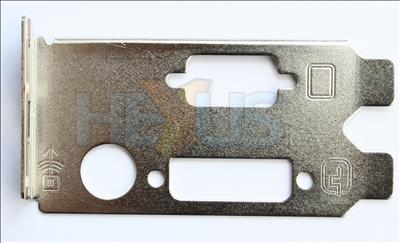
Given the low-profile nature of the card, you can remove the standard bracket and fit a thinner (but taller) version that's better-suited to smaller cases where bracket width is a concern. This is good thinking from HIS, and it bundles in the necessary bracket in the package.
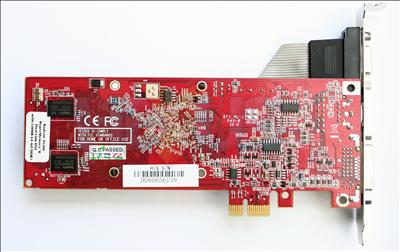
Nothing much of note on the rear. A simple, understated card that stands out due to its half-height PCB and x1 PCIe interface. Wouldn't it have been even better if it sported a HDMI connector, perfect for the plethora of high-definition LCD/plasma TVs currently available?









